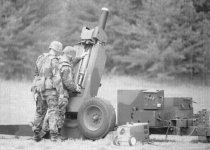
Marine Corps News 05/22/2000 04:07:02 PM
MARINE CORPS WARFIGHTING LAB SHOWS OFF NEW MORTAR SYSTEM
By Cpl. James Covington
MARINE CORPS BASE QUANTICO, Va. (May 19) -- The Marine Corps Warfighting Lab displayed its new, experimental mortar system, the Mobile Fire Support System, May 5 at a firing demonstration on Range 5.
The MFSS is a rifled 120mm mortar system. It is the first remotely fired mortar system.
"It can be fired from anywhere within [range of] communication" said Forrest Lindsey, the senior engineer at the Warfighting Lab. "We can actually put a satellite receiver on it and fire it by satellite."
The MFSS is equipped with its own Global Positioning System, field radio and fire control computer. The turret has power traverse, elevation and loading capabilities. When the system receives a fire mission over the radio, it can turn, load and fire, within 12 seconds.
"We've designed the very first robotic gun," Lindsey said. "It allows us to respond faster and much more accurately to fire missions."
The new system has a range of 8.2 kilometers and 13 kilometers when using Rocket Assisted Projectiles. During a test fire, the MFSS, firing from 6,000 meters away, placed nine rounds within a 2-meter circle.
"We have the capability to provide lethal and accurate fire support," said Maj. Lance McDaniel, the ground combat representative for the advanced technology division of the Warfighting Lab. "We're looking to achieve first-round fires for effect."
The MFSS system's mobility makes it a very agile weapon.
"We're looking for it to be a weapon that can be towed by a hum-vee [Highly Mobile Multipurpose Wheeled Vehicle], carried in a V-22 [Osprey], pushed out of a V-22 and set up 200 nautical miles inland," Lindsey said. "Once the LAV body kit catches up, we're looking at making it modular, so individuals can lift the cannon section off, put it on the LAV and move it as a self-propelled artillery piece."
The MFSS project started in 1996 when Col. Anthony Wood, then the director of the Warfighting Lab wanted to develop a mortar that could be placed in an isolated location and fired remotely.
The mortar system is a result of the combined efforts of the Warfighting Lab; Picatinney Arsenal, N.J.; Rock Island Arsenal, Ill.; Allied Signal Corporation; L3 communications and Thomson Daimler Armaments of France.
The system is still experimental and is not scheduled to replace any existing system in the Marine Corps inventory.
"In the Warfighting Lab, we build and demonstrate experimental systems," Lindsey said. "It's up to the fleet and the Combat Development Command to decide what the Marine Corps will use."
If incorporated, the new system will make a significant difference to the gun crews that will fire the weapon on the battlefield.
"The gun crew can occupy and fire from trenches 50 to 100 meters away," said Lindsey. "If counter fire comes in, the gun crew is down in the trenches protected from enemy fire."
-30-



